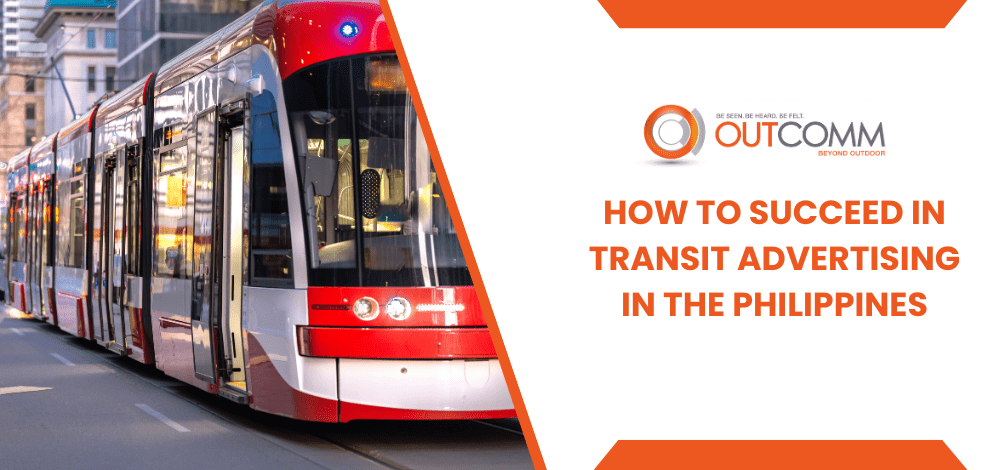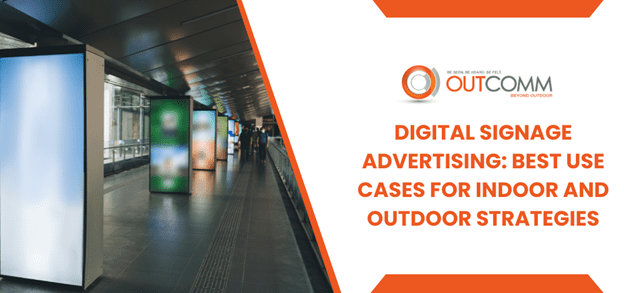
Introduction
Next to billboards, transit advertising is one of the most common out-of-home media formats in the Philippines. Commuters like you will know it too well — there is no shortage of ad posters and displays on buses, taxis, and trains.
The key appeal of this format? They move around. Unlike with billboards that are stuck in one location, a brand that uses transit advertising will have high hopes of reaching more people from different places.
Of course, transit advertising will only be effective if you can maximize and unleash its full potential. To ensure your success, Outcomm has several tips that you can consider for your next advertising campaign.
Ways To Ensure Your Brand’s Transit Advertising Campaigns in the Philippines Succeed
From choosing which type of transit ad to use to including a clear call-to-action in your messaging, every step you take before the campaign launch itself is essential to success. The following are helpful steps you can take.
Weigh the Types of Transit Ads
Transit advertising in the Philippines usually comes in three general types: bus ads, taxi ads, and transit ads. Essentially, you want your brand to reach people who are likely to pay attention to your message, and the captive audience will sometimes depend on the type of transport you target for your campaign.
Bus Ads
To make a bus advertising campaign in the Philippines effective, do not just place ads on any bus you find. Determining which audience you aim to reach can narrow the potential places where you can launch your campaign. For instance, if your target includes employed women in their 20s to 30s, putting up ads on buses that pass through business district roads increases the chances of your target demographics seeing the ad.
Taxi Ads
When you launch taxi advertising campaigns in the Philippines, you can install them inside or outside the cab. The key here is to partner with operators so you can leverage a fleet of taxis to carry your message. Airport taxis are particularly a good choice for your ads, as you can typically target travelers or the balikbayan — many niche products and services resonate with this demographic.
Train Ads
Advertising in train stations in the Philippines is effective in imprinting your brand in the public’s mind, especially if you place your messaging so it can catch the attention of idle commuters or those who are waiting to board the train. Putting the ads on the platforms, then following them up with ad stickers inside the train, may make passengers curious about your brand. You just need to customize your messaging so it resonates with your audience.
Study Your Captive Audience
Whether you are advertising on Light Rail Transit (LRT) platforms or inside taxis in the Philippines, it is essential that you study your target audience first. Learning about the traffic volume, demographics, and usual destinations of the commuters you are targeting will help you determine which product or service to advertise and what your messaging approach will look like.
Commuters are usually in a hurry, so you would want to get your message across even when your audience has only a glance to spare for your train or taxi ad. One way to do this is to learn about the common pain points of your target audience and address them with your ad message.
Keep Your Messaging Relevant
Sometimes, the idea that thousands of commuters will see your ad every day becomes a trap when you focus on traffic volume alone. It will not matter that many people will pass by your ad if your messaging is not relevant to them. More critical than targeting high-traffic locations is considering where your audience is going, what they’re doing, and how they want to spend their money.
For instance, launching an advertising campaign in LRT stations in the Philippines for a restaurant may not resonate with the people taking the train, who are commuting to their workplace. Placing that kind of ad in buses with regular drop-off in malls might be more effective, as there is likely a bus passenger who has plans to visit the mall to dine out.
Create Engaging Visuals
Commuters may not care for ads when they’re running late, unless your ad is designed to stop them in their tracks, even for a second. The hustle and bustle in train stations in the Philippines, particularly the busy Metro Rail Transit (MRT) line, pose challenges in creating captivating advertising materials.
You can rise up to the challenge by testing different ad designs, switching up your messaging, and planning your campaign to align with the season or special events. For instance, if you are advertising for a job-hunting platform, starting your campaigns in the middle of the year, or from July to September, when most companies hire new people, may resonate better with your target audience. Advertising one-time events, like a concert or a sports tournament, may also pique the passengers’ interest better.
Include a Clear Call-to-Action
When advertising in busy train stations in the Philippines, like the MRT, it is imperative that you are not only concise with your messaging, but you are also clear about what you want your target audience to do. If you are selling a product that they can buy online, including a QR code or the name of your online shop when directing them to purchase an item is one example of a clear call-to-action (CTA).
Ads targeting commuters will hold people’s attention only for a short period, so you’d want to tell them what you want them to do as soon as possible. Combining a concise, exact CTA with intentional graphic design is essential, too, as good design will naturally lead your audience’s eyes to your primary message.
Frequently Asked Questions About Transit Advertising in the Philippines
What Is a Major Advantage of Transit Advertising?
One major advantage of transit advertising is that your assets are moving with the vehicles. Basically, you bring your brand closer to the commuters. They can see your message when they board the train, ride the bus, or hire a cab. Moreover, pedestrians who can see the vehicles passing may also look at the ad, increasing the chances of your brand being recognized in different locations.
In addition to this advantage, you also have the chance to show your brand to your audience repeatedly. After all, many commuters take a fixed route when going to work or school. If your campaign lasts three months, the passengers will likely see your ad for approximately three months as well.
Displaying your brand regularly to these same passengers may help imprint your business into their minds. Of course, before these commuters can recall your brand, you have to attract their attention first, either with arresting visuals or a message that resonates with them.
Why Is Transit Advertising a Good Choice for Promoting Local Businesses?
Public transportation, especially buses, follows a regular route within a city or town. This setup is favorable to local businesses that want to promote their brands locally, because the captive audience is likely closer to the store or product they are promoting.
Phrasing your message so that commuters can learn that the brand is within their area can be an effective way to nudge them into checking your business. Including store hours and the approximate distance of the shop from the station is helpful information that can further encourage potential customers.
How Does Transit Advertising Capture the Attention of Commuters?
Transit advertising can get the attention of commuters by including a relatable message or a proposition that addresses their needs. For instance, some of the train passengers may be considering buying a new smartphone. Boarding the MRT or LRT and seeing an ad for a new phone model can just be the final step they need to make the purchase finally.
Another strategy to capture your target audience’s customers is to make your advertisement interactive and engaging. A touchscreen feature or a QR code to check the smartphone’s specifications can pique passengers’ interest or help reduce the boredom they might be feeling while waiting for the next train.
Conclusion
A successful transit advertising campaign in the Philippines requires careful planning to pull off. First, you need to consider which type of transit ad you will use, or whether you need to explore all available options. Next is to study your target audience’s demographics, which can vary depending on the transit ad location. To hold their attention, you should also consider the audience’s characteristics and likely motivations and tailor your message to resonate with them. You should also design visuals that appeal to many and establish a consistent and clear call-to-action in your advertisements to gain solid results.
Starting a transit advertising campaign can be challenging, but with the right agency, you can have all the advice and support you need to succeed. Outcomm is one of the companies that can help you. Contact our team today to learn more!






